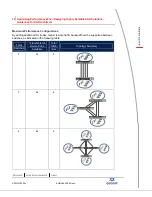
Network Traffic
Engineering
Guidelines for Fibre
Channel Switches
Optimizing Performance When Designing Highly
Scalable SAN Solutions:
Guidelines for SAN Architects
Executive Summary
Before the advent of stackable switch solutions, storage area
network (SAN) architects had to trade scalability vs.
performance. Data traffic across the network was limited to
relatively few inter-switch links (ISL).
QLogic stackable switch solutions solve the
scalability/performance dilemma. Each model in the
SANbox
®
5000 series features a 4 pack of high-speed
(10Gb) stacking ports that enable a SAN architect to scale
seamlessly and maintain high performance. Connecting
switches together using the dedicated stacking trunks
preserves all 4Gb ports for use by servers and storage
devices.
QLogic’s highly scalable SAN solutions allow your network
traffic engineer to maximize overall performance and to minimize cost.
Key Findings
By following simple network engineering guidelines, SAN switch solutions can be created to balance
scalability and performance:
•
Rule A: Localized Traffic. Connect critical server and storage devices connected to a single switch
to maximize throughput and minimize latency.
•
Rule B: Remote/ISL Traffic. Avoid oversubscription by utilizing high bandwidth ISLs/trunks and
placing servers and storage across switches so the I/O operations load for remote traffic is less
than or equal to the capacity of inter-switch trunks. The QLogic SANbox 5200, 5600, and 5602
stackable switches also preserve 2Gb/4Gb ports for connections to server and storage devices.
A stackable solution and topology using SANbox 5000 series switches balance overall performance
and cost; whereas fixed-port solutions increase in cost faster and deliver less bandwidth between
switches.





























